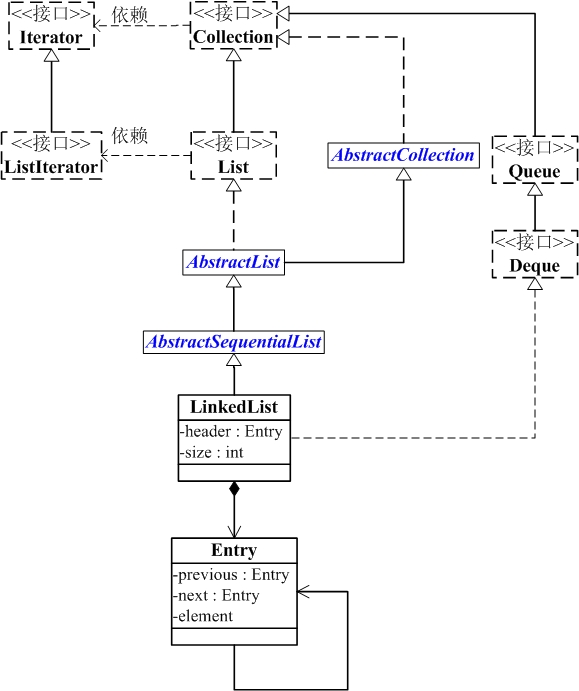
LinkedList的本质是双向链表。
(01) LinkedList继承于AbstractSequentialList,并且实现了Dequeue接口。
(02) LinkedList包含两个重要的成员:header 和 size。
header是双向链表的表头,它是双向链表节点所对应的类Entry的实例。Entry中包含成员变量: previous, next, element。其中,previous是该节点的上一个节点,next是该节点的下一个节点,element是该节点所包含的值。
size是双向链表中节点的个数。
(前面照旧是复制粘贴的图和文字,大家大概理解一下,下面进入正题)
为了理解上面的概念,首先我们来看一下核心类Node
//节点,有前驱,后继和值三个字端,其中前驱和后继也是节点
private static class Node<E> {
E item;
Node<E> next;
Node<E> prev;
Node(Node<E> prev, E element, Node<E> next) {
this.item = element;
this.next = next;
this.prev = prev;
}
}
Node表示的是结点,结点里面有三个元素:
数据,前驱和后继。
其中数据可是任意类型,前驱和后继同样是结点。
我们可以想象一个双向链表依次一共有A,B,C三个结点,他们的数据分别为a,b,c。那么:
A的前驱为null,后继为B,数据为a。
B的前驱为A,后继为C,数据为b。
C的前驱为B,后继为null,数据为c。
接下来我们来看一下构造函数和类变量
//集合元素个数
transient int size = 0;
//第一个节点
transient Node<E> first;
//最后一个节点
transient Node<E> last;
//输入为空的构造函数
public LinkedList() {
}
//直接传入一个Collection放入LinkedList中的构造器,
public LinkedList(Collection<? extends E> c) {
//调用无参的构造期
this();
addAll(c);
}
类变量分别是List中数据的个数,第一个结点和最后一个结点。
构造函数有两个:一个是空的构造函数,一个是传入一个Collection来生成LinkedList。
我们来具体看一下这个addAll方法
//将指定集合c中所有的元素,按照其迭代器返回的顺序全部追加到集合的结尾。
public boolean addAll(Collection<? extends E> c) {
return addAll(size, c);
}
//将指定集合c中所有的元素,按照其迭代器返回的顺序全部追加到集合的特定位置。
public boolean addAll(int index, Collection<? extends E> c) {
checkPositionIndex(index);
Object[] a = c.toArray();
int numNew = a.length;
if (numNew == 0)
return false;
//pred是predecessor前置节点,succ是succeed 后置节点,请大家学好英语(笑)
Node<E> pred, succ;
if (index == size) {
//新增节点在最后一个
succ = null;
pred = last;
} else {
//新增结点在index处
succ = node(index);
pred = succ.prev;
}
//前驱节点不为null的情况下,循环生成新节点,把前任节点作为新节点的前驱,数组里的数作为节点的值,后继置为空
//然后把新节点作为前驱的后继,之后把新节点作为前驱,继续循环执行
//可能你这个时候会有疑问,那不是没有制定后继?并不是的,后继是在你的新节点变为前驱后,由 pred.next = newNode;这一句指定的。
for (Object o : a) {
@SuppressWarnings("unchecked") E e = (E) o;
Node<E> newNode = new Node<>(pred, e, null);
if (pred == null)
first = newNode;
else
pred.next = newNode;
pred = newNode;
}
//后继为空,则最后一个就是前驱(也就是前面最后一句指定为前驱的newNode)
//后继不为空的话,则把后继作为前驱(就是前面最后一句指定为前驱的newNode)的后继,前驱作为后继的前驱
if (succ == null) {
last = pred;
} else {
pred.next = succ;
succ.prev = pred;
}
//列表里的数增加
size += numNew;
//这个用来判断迭代器的fast-fail的,具体见我的前一篇ArrayList的那篇博文
modCount++;
return true;
}
整个把Collection变为LinkedList的过程写的比较详细了,不再赘述。
现在我们随便看一些常用的方法,比如说获取第一个结点的值,我们发现会有getFirst()和peekFirst()这样两个方法;同样的获取最后一个结点的值,我们发现会有getLast()和peekLast()两个方法。那么为何会有两种呢?
我们看一下源码:
//获取第一个结点的值
public E getFirst() {
final Node<E> f = first;
if (f == null)
throw new NoSuchElementException();
return f.item;
}
//获取的第一个结点的值
public E peekFirst() {
final Node<E> f = first;
return (f == null) ? null : f.item;
}
我们可以看出来,前者如果结点为空会报错,后者如果结点为空则会返回null。
以下对第一个结点和最后一个结点的操作:
第一个结点(头部) 最后一个结点(尾部)
抛出异常 特殊值 抛出异常 特殊值
插入 addFirst(e) offerFirst(e) addLast(e) offerLast(e)
移除 removeFirst() pollFirst() removeLast() pollLast()
检查 getFirst() peekFirst() getLast() peekLast()
左边的操作遇到异常会抛出异常,右边的操作遇到异常会返回特殊值。
由于LinkedLIst分别实现了队列和栈的接口,以下也是对第一个结点和最后一个结点的操作
当作为队列时,下表的方法等价:
队列方法 等效方法 add(e) addLast(e) offer(e) offerLast(e) remove() removeFirst() poll() pollFirst() element() getFirst() peek() peekFirst()
当作为栈时下表的方法等价:
栈方法 等效方法 push(e) addFirst(e) pop() removeFirst() peek() peekFirst()
以上说的都是对第一个结点和最后一个结点的操作,接下来写一下对中间结点的操作:
//返回特定位置的结点的值
public E get(int index) {
checkElementIndex(index);
return node(index).item;
}
//替换特定位置的结点的值,返回旧的值
public E set(int index, E element) {
checkElementIndex(index);
Node<E> x = node(index);
E oldVal = x.item;
x.item = element;
return oldVal;
}
//替换特定位置的结点,原结点向后移
public void add(int index, E element) {
checkPositionIndex(index);
if (index == size)
linkLast(element);
else
linkBefore(element, node(index));
}
//删除特定位置的结点
public E remove(int index) {
checkElementIndex(index);
return unlink(node(index));
}
里面的具体操作如下:
//获取某个index的结点
Node<E> node(int index) {
// assert isElementIndex(index);
if (index < (size >> 1)) {
Node<E> x = first;
for (int i = 0; i < index; i++)
x = x.next;
return x;
} else {
Node<E> x = last;
for (int i = size - 1; i > index; i--)
x = x.prev;
return x;
}
}
//把输入的数e作为新增在最前面的结点的值
private void linkFirst(E e) {
final Node<E> f = first;
final Node<E> newNode = new Node<>(null, e, f);
first = newNode;
if (f == null)
last = newNode;
else
f.prev = newNode;
size++;
modCount++;
}
//把输入的数e作为新增在最后面的结点的值
void linkLast(E e) {
final Node<E> l = last;
final Node<E> newNode = new Node<>(l, e, null);
last = newNode;
if (l == null)
first = newNode;
else
l.next = newNode;
size++;
modCount++;
}
//把输入的数e作为新增在结点succ的前面的结点的值
void linkBefore(E e, Node<E> succ) {
// assert succ != null;
final Node<E> pred = succ.prev;
final Node<E> newNode = new Node<>(pred, e, succ);
succ.prev = newNode;
if (pred == null)
first = newNode;
else
pred.next = newNode;
size++;
modCount++;
}
//把非空的LinkedList的第一个节点unlinked(删除)
private E unlinkFirst(Node<E> f) {
// assert f == first && f != null;
final E element = f.item;
final Node<E> next = f.next;
f.item = null;
f.next = null; // help GC
first = next;
if (next == null)
last = null;
else
next.prev = null;
size--;
modCount++;
return element;
}
//把非空的LinkedList的最后一个节点unlinked(删除)
private E unlinkLast(Node<E> l) {
// assert l == last && l != null;
final E element = l.item;
final Node<E> prev = l.prev;
l.item = null;
l.prev = null; // help GC
last = prev;
if (prev == null)
first = null;
else
prev.next = null;
size--;
modCount++;
return element;
}
///把非空的LinkedList的某个节点unlinked(删除)
E unlink(Node<E> x) {
// assert x != null;
final E element = x.item;
final Node<E> next = x.next;
final Node<E> prev = x.prev;
if (prev == null) {
first = next;
} else {
prev.next = next;
x.prev = null;
}
if (next == null) {
last = prev;
} else {
next.prev = prev;
x.next = null;
}
x.item = null;
size--;
modCount++;
return element;
}
可以从上面看出来新增和删除元素都是比较方便的。
还有两个比较特殊的删除方法:
//删除第一个出现的特定值
public boolean removeFirstOccurrence(Object o) {
return remove(o);
}
//删除最后一个出现的特定值
public boolean removeLastOccurrence(Object o) {
if (o == null) {
for (Node<E> x = last; x != null; x = x.prev) {
if (x.item == null) {
unlink(x);
return true;
}
}
} else {
for (Node<E> x = last; x != null; x = x.prev) {
if (o.equals(x.item)) {
unlink(x);
return true;
}
}
}
return false;
}
它们的特殊之处在于,它们想要删除的结点的数值也许有很多个,但是它们只会删除第一个出现的或者是最后一个出现的。
然后我们看一下搜索元素的方法:
//判断是否包含某个特定的结点的值
public boolean contains(Object o) {
return indexOf(o) != -1;
}
//查找LinkedList中是否包含某个值,并返回第一个出现这个值的索引值,否则返回-1
public int indexOf(Object o) {
int index = 0;
if (o == null) {
for (Node<E> x = first; x != null; x = x.next) {
if (x.item == null)
return index;
index++;
}
} else {
for (Node<E> x = first; x != null; x = x.next) {
if (o.equals(x.item))
return index;
index++;
}
}
return -1;
}
//反向查找LinkedList中是否包含某个值,并返回第一个出现这个值的索引值,否则返回-1
public int lastIndexOf(Object o) {
int index = size;
if (o == null) {
for (Node<E> x = last; x != null; x = x.prev) {
index--;
if (x.item == null)
return index;
}
} else {
for (Node<E> x = last; x != null; x = x.prev) {
index--;
if (o.equals(x.item))
return index;
}
}
return -1;
}
可以看出来,搜索元素是比较麻烦的,必须要全部遍历一遍。
最后我们看一下一些边界值判断的方法:
//判断某个索引值是否存在
private boolean isElementIndex(int index) {
return index >= 0 && index < size;
}
//判断这个索引是否超出了位置的边界,这个和上面的有何区别?为何index是<=而不是<
private boolean isPositionIndex(int index) {
return index >= 0 && index <= size;
}
//多种边界异常的判断
private String outOfBoundsMsg(int index) {
return "Index: "+index+", Size: "+size;
}
private void checkElementIndex(int index) {
if (!isElementIndex(index))
throw new IndexOutOfBoundsException(outOfBoundsMsg(index));
}
private void checkPositionIndex(int index) {
if (!isPositionIndex(index))
throw new IndexOutOfBoundsException(outOfBoundsMsg(index));
}
限于篇幅(Lan),其他方法就不一一介绍了。
总结:
1.LinkedList的本质基于双向链表实。
2.LinkedList在查找元素时,必须遍历链表;在新增和删除元素时,只要调整前后的引用就可以了。
3.LinkedList不是线程安全的,同样拥有fast-fail机制。
来源:https://www.cnblogs.com/jing-daye/p/7242576.html